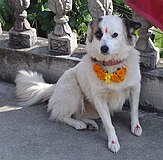Tihar
Tihar (Nepali: तिहार) Kirat language and culture is a five-day-long Nepali festival celebrated in Nepal and the Nepali people of Indian states of Sikkim including in Darjeeling district of West Bengal. It is the festival of lights, as diyas are lit inside and outside the houses to make it illuminate at night. It is popularly known as Swanti and Mha worship among the Newars and as Deepawali among Madhesis.[3]Set in the Vikram Samvat calendar, the festival begins with Kaag Tihar in Trayodashi of Kartik Krishna Paksha and ends with Bhai Tikain Dwitiya of Kartik Sukla Paksha every year.[4]
Tihar is the second biggest Nepalese festival after Dashain. It is considered to be of great importance as it shows a contribution to not just the humans and the gods, but also to the animals like crows, cows, and dogs that maintain an intimate relationship with humans. People make patterns on the floor of living rooms or courtyards using several coloured flowers in ancients days nowadays they use the materials such as colored rice, dry flour, colored sand or flower petals outside their house, called Rangoli, which is meant to be a sacred welcoming area for the Gods and Goddesses, mainly Goddess Laxmi.[5][6]
Crows and ravens are worshiped by offerings of sweets and dishes placed on the roofs of houses. The cawing of crows and ravens symbolizes sadness and grief in Nepali culture, so devotees offer crows and ravens food to avert grief and death in their homes. Tihar represents the divine attachment between humans and other animals.
Another interesting observation during Tihar days in Nepal is gambling: during the days of the festival, it's allowed to gamble, while the rest of the year it's illegal for Nepalese citizens to gamble.[7]
Kaag Tihar (Day 1)
Kaag Tihar (Crow Festival) is the first day of Tihar festival of Nepalese, Hindu people. In this particular day crow is worshipped. Religious belief in Nepal regard crow as messenger of Yamraja, the god of death. People worship it to bring good luck in their houses. People also put tika and burn fire crackers in this day.
Kukur Tihar (Day 2)
The second day is called Kukur Tihar (Dog Festival).[8]. People offer garlands, tika and delicious food to dogs and acknowledge the cherished relationship between humans and dogs.
Dogs occupy a special place in every home or street and they get special treatment in this day. As mentioned in the Mahabharata, Bhairava, a fierce manifestation of Lord Shiva, had a dog as a vahana (vehicle). Yama, the god of death, is believed to own two guard dogs – each with four eyes. The dogs are said to watch over the gates of Naraka, the Hindu concept of Hell.[9] Owing to this belief, this day is also observed as Naraka Chaturdashi.

Comments
Post a Comment